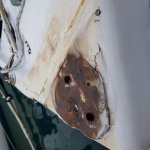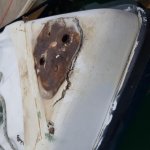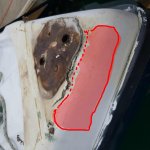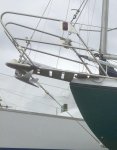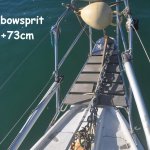yourmomm
Member
One of the jobs I had to do on my boat (amongst many) was remove the stainless bowsprit, (really just an extended pulpit, which has somehow managed to stay there 20 years plus), to get it to engineers for repair (it was badly bent, after previous owner left mooring lines over it!). This is what I found underneath (attached, port and starboard views of bow).
The fibreglass is knackered, and under the gunk will only be the same. The thing I'm thinking is that this damage was not caused by the mooring line incident (?although I suppose it might have been?). I'm concerned that the damage seems more indicative of the fibreglass delaminating badly, literally ripped apart, possibly over a long time, by the upward force from the forestay (attached to end of bowsprit), as well as the sternward force from the bowsprit: this damage is by two mounting bolts on the deck, (holes visible) which form part of the bowsprit's mountings to the hull itself (there are four additional bolts: two, both port and starboard on the gunnel, also fixing it to the hull, and there seems to be no similar damage around these areas).
I'm assuming I need to grind all of this delaminated glass out, and re do. But how to make this repair strong enough? I'm assuming just layering the glass cloth in the hole I grind out will have little strength, particularly to resist upward force from the forestay. Can someone advise me step by step what I need to do here? Do I need to grind out much more than the damaged area, to provide additional support for any new glass I layer in? How many layers do I need? (I've got lots of biaxial cloth and epoxy left over from a previous job).
As an aside, does polyester/glass (which is what this is) weaken, over time? There's a few areas ive found on this 50y/o boat, which apparently need strengthening.
Many thanks.
The fibreglass is knackered, and under the gunk will only be the same. The thing I'm thinking is that this damage was not caused by the mooring line incident (?although I suppose it might have been?). I'm concerned that the damage seems more indicative of the fibreglass delaminating badly, literally ripped apart, possibly over a long time, by the upward force from the forestay (attached to end of bowsprit), as well as the sternward force from the bowsprit: this damage is by two mounting bolts on the deck, (holes visible) which form part of the bowsprit's mountings to the hull itself (there are four additional bolts: two, both port and starboard on the gunnel, also fixing it to the hull, and there seems to be no similar damage around these areas).
I'm assuming I need to grind all of this delaminated glass out, and re do. But how to make this repair strong enough? I'm assuming just layering the glass cloth in the hole I grind out will have little strength, particularly to resist upward force from the forestay. Can someone advise me step by step what I need to do here? Do I need to grind out much more than the damaged area, to provide additional support for any new glass I layer in? How many layers do I need? (I've got lots of biaxial cloth and epoxy left over from a previous job).
As an aside, does polyester/glass (which is what this is) weaken, over time? There's a few areas ive found on this 50y/o boat, which apparently need strengthening.
Many thanks.
Attachments
Last edited:

